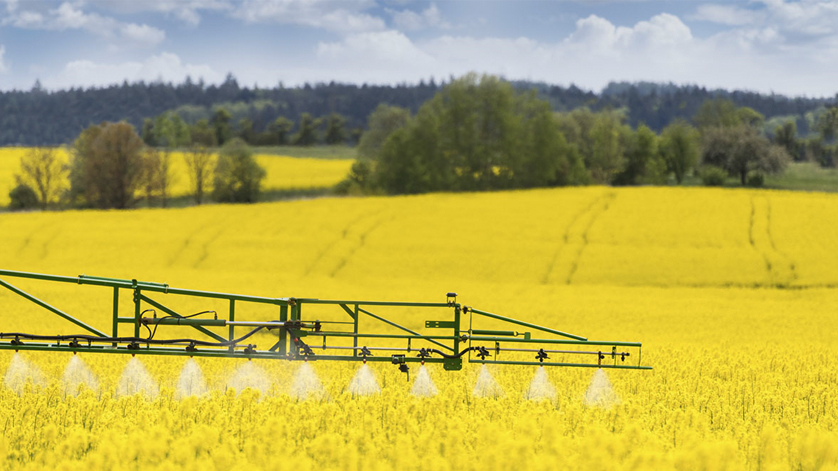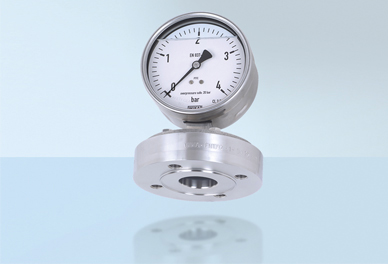
The high requirements placed on pesticides and their production are also reflected in the pressure measurement in the process. A WIKA customer has therefore supplemented the electronic instrumentation for pressure monitoring with a mechanical backup. For this redundancy, the company uses WIKA model 433.50 diaphragm pressure gauges – because their measuring principle also offers a design advantage.
The comprehensive safety standards reflect the hazard potential that arises from the processing of the basic and intermediate products. For example, vapours are produced that are toxic and react with air. Seamless monitoring of the process parameters is therefore indispensable. For this reason, WIKA’s customer has integrated a mechanical component, in addition to the electronic one, into the pressure measurement in their pesticide production. Thus, even in the event of a power failure, they reliably receive a measured value, which is then displayed locally.
The reasons for a diaphragm pressure gauge as redundancy in pressure measurement
For the instrumentation of the redundancy, the customer decided in favour of the model 433.50 diaphragm pressure gauge. The following reasons spoke in favour of this instrument:

Optimal for redundant pressure measurement in pesticide production: the model 433.50 diaphragm pressure gauge from WIKA.
1. The flexibility of use
The pressure gauge can be installed at different measuring locations, due to a wide selection of measuring ranges between 0 … 16 mbar and 0 … 25 bar. It thus reduces the instrument variance.
2. The robust design
The robust model 433.50 has a high overload safety: up to ten times the full scale value. Its case filling – glycerine in the case of pesticide production – ensures reliable pressure measurement under vibration and high dynamic pressure loads. The design with open flange connection also enables a safe process connection.
3. The resistance against the medium
During the production of pesticides, vapours with temperatures from +120 °C are produced. The pressure gauge can withstand medium temperatures up to +200 °C. It is also resistant to aggressive substances. This resistance can be increased by using versions with special materials. In the case of this application, a variation with a PTFE lining of the lower measuring flange was necessary (the fact that this reduced the temperature resistance to 160 °C did not matter at the measuring locations concerned). In addition, for the manufacturing process, WIKA also supplied an instrument version with ATEX approval.
4. The process remains closed in the event of case damage
The diaphragm pressure gauges in the application have a case with a nominal size of 100, so that the measured value can be read without difficulty, even when simply passing by. Consequently, the measuring instrument protrudes into the environment. If scaffolding is used for maintenance work on the production facilities, damage to the case cannot be ruled out. With a Bourdon tube pressure gauge, the measuring system would also leak in that event, and dangerous media could escape. The diaphragm pressure gauge, on the other hand, transmits the pressure to the movement via a diaphragm and link. This means that the diaphragm continues to keep the process closed even if the case is damaged.
Conclusion
Pressure gauges provide a reliable measuring result, without external energy, in any situation. This is why redundant pressure measurement using mechanical instruments significantly increases plant safety. Diaphragm pressure gauges are the first choice for processes with low pressures and critical media.
Note
Further technical details on the model 433.50 diaphragm pressure gauge can be found on the WIKA website. There you will also find an overview of other products and solutions for the chemical sector, as well as a corresponding brochure for downloading. Would you like to buy diaphragm pressure gauges? In our WIKA online-shop you will find some of our standard designs. If you have any questions, your contact will gladly help you.
Also read our posts
Advantages of diaphragm pressure gauges (1): Measurement of low pressures
Advantages of diaphragm pressure gauges (2): High overload protection
Advantages of diaphragm pressure gauges (3): Solution for critical media
Lasting accuracy for diaphragm seal systems for vacuum process
Watch the following video to learn about the differences between the measuring principles of Bourdon tube pressure gauges and diaphragm pressure gauges.

